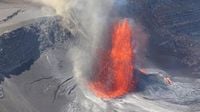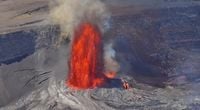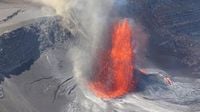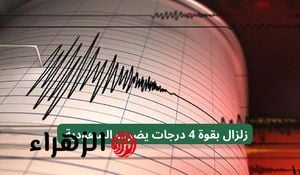The Kilauea Volcano in Hawaii has erupted spectacularly, sending lava fountains soaring to heights of up to 215 meters, according to the United States Geological Survey (USGS). This recent activity marks a significant episode in the ongoing eruptions that began in December 2024.
On April 1, 2025, the volcano displayed a violent eruption from its southern vent, prompting immediate warnings to residents in the surrounding areas. The eruption intensified on April 2, with lava rising to over 70 meters early in the day, before surpassing the 215-meter mark by 10:50 AM local time.
While the breathtaking sight of lava fountains is captivating, it also poses serious risks. The USGS has cautioned that volcanic gas emissions, particularly sulfur dioxide, remain elevated, potentially leading to toxic volcanic smog. During previous periods of inactivity, sulfur dioxide emissions were recorded at approximately 1,000 tons per day.
As the lava continues to flow, scientists are closely monitoring the situation. Observations from the Hawaiian Volcano Observatory indicate that the magma reservoir at the summit of Kilauea is beginning to refill, suggesting that further eruptions may be on the horizon.
The Kilauea volcano is classified as a shield volcano, known for its fluid lava flows. Its eruptions are characterized by the outpouring of liquid lava rather than explosive activity. This latest phase of eruptions has included a series of lava fountain episodes interspersed with periods of relative calm, all occurring within the Halemaʻumaʻu crater, which minimizes direct threats to nearby residents.
Despite the reduced immediate danger to local communities, the USGS has urged caution. The ongoing activity has been accompanied by emissions of volcanic gases and wind-blown particles of volcanic glass, known as Pele's hair, as well as tephra, which can affect both human health and the environment.
As the situation unfolds, the USGS continues to use advanced technologies, including tilt meters and seismographs, to monitor changes in the volcano’s behavior. These tools allow scientists to detect shifts in the terrain and seismic activity, providing critical data for predicting future eruptions.
The Kilauea volcano is one of the most active volcanoes in the world, and its eruptions have been closely studied for their geological significance and impact on local communities. The recent events serve as a reminder of the dynamic and often unpredictable nature of volcanic activity.
Residents and visitors in the region are advised to stay informed and heed warnings from local authorities as the situation develops. The USGS is committed to providing timely updates to ensure public safety and awareness during this active period.
In summary, the Kilauea volcano's latest eruption has captivated observers with its impressive lava fountains while simultaneously raising concerns about air quality and safety in the surrounding areas. As scientists continue to monitor the volcano, the potential for future eruptions remains a critical focus.

![Wybuch wulkanu Kilauea, lawa strzela aż do nieba [WIDEO]](https://thumbor.evrimagaci.org/gUYaeDpb0u2GC8AT4BXMYeLbK1s=/200x0/tpg%2Fsources%2F4eb4c5b6-f4b2-42aa-bc85-b796112e8bf8.jpeg)





